A Comprehensive Analysis of Theories, Principles & Models in Education
VerifiedAdded on 2023/06/12
|19
|6385
|98
Report
AI Summary
This report provides a comprehensive analysis of theories, principles, and models applied to education and training. It explores various learning theories such as behaviorism, humanism, and models like pedagogy and andragogy. The report also discusses communication theories and models, including the Shannon-Weaver model and the Transactional model, and their application in teaching and assessment. Furthermore, it examines assessment theories, principles, and models, along with theories and models of curriculum development and reflection. The document concludes by analyzing theories and models of reflection and evaluation, demonstrating their application in reviewing one's own practice. This assignment is available on Desklib, a platform offering various study tools and resources for students.
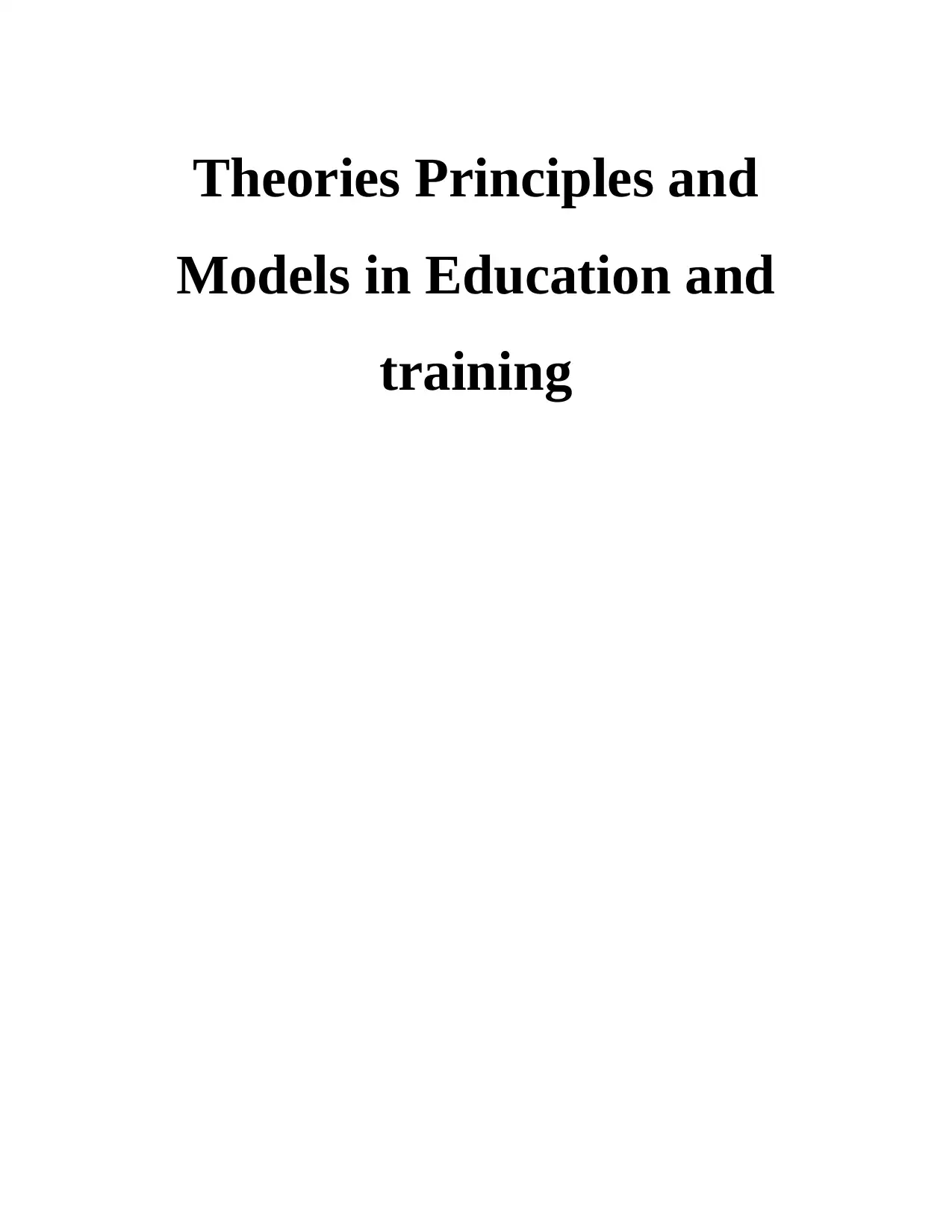
Theories Principles and
Models in Education and
training
Models in Education and
training
Paraphrase This Document
Need a fresh take? Get an instant paraphrase of this document with our AI Paraphraser
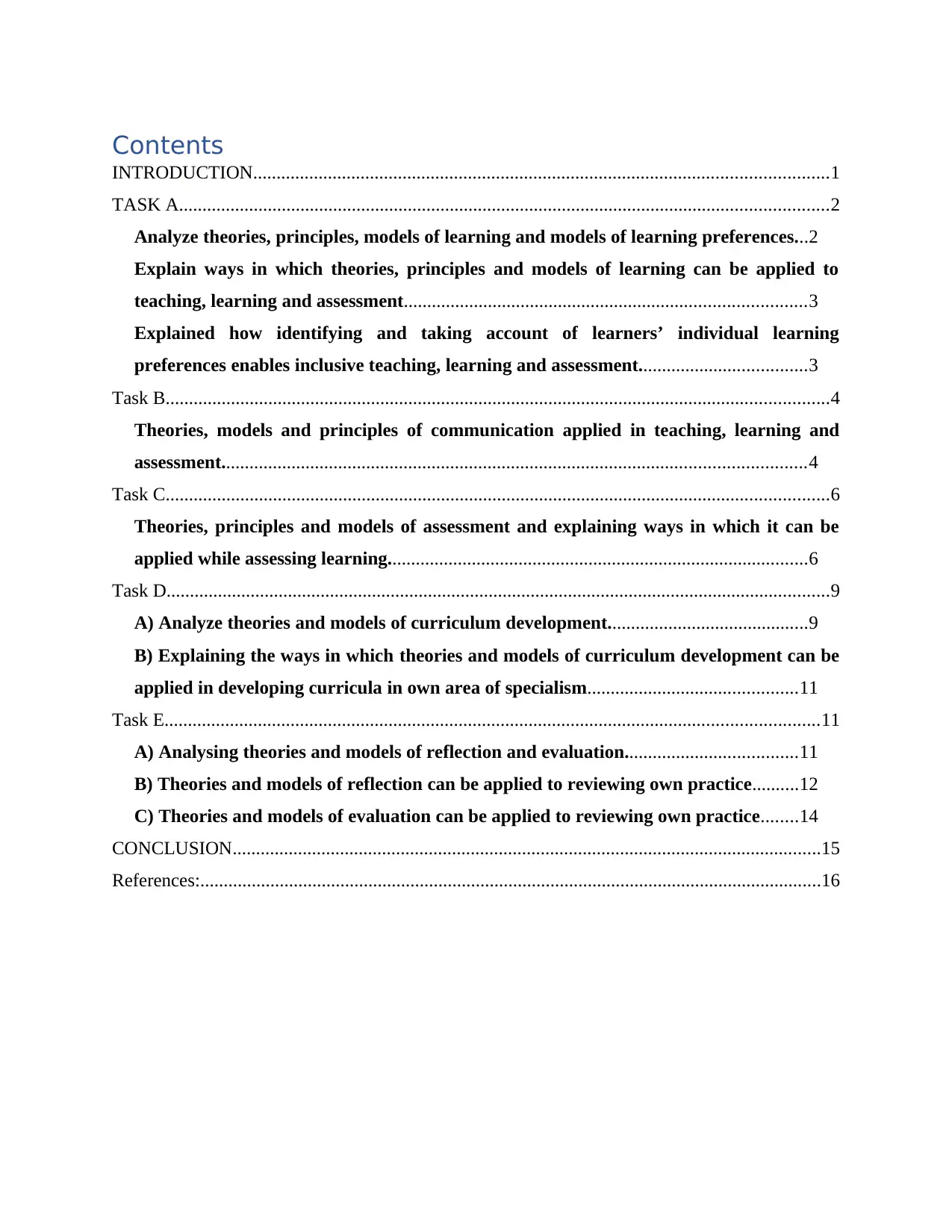
Contents
INTRODUCTION...........................................................................................................................1
TASK A...........................................................................................................................................2
Analyze theories, principles, models of learning and models of learning preferences...2
Explain ways in which theories, principles and models of learning can be applied to
teaching, learning and assessment......................................................................................3
Explained how identifying and taking account of learners’ individual learning
preferences enables inclusive teaching, learning and assessment....................................3
Task B..............................................................................................................................................4
Theories, models and principles of communication applied in teaching, learning and
assessment.............................................................................................................................4
Task C..............................................................................................................................................6
Theories, principles and models of assessment and explaining ways in which it can be
applied while assessing learning..........................................................................................6
Task D..............................................................................................................................................9
A) Analyze theories and models of curriculum development...........................................9
B) Explaining the ways in which theories and models of curriculum development can be
applied in developing curricula in own area of specialism.............................................11
Task E............................................................................................................................................11
A) Analysing theories and models of reflection and evaluation.....................................11
B) Theories and models of reflection can be applied to reviewing own practice..........12
C) Theories and models of evaluation can be applied to reviewing own practice........14
CONCLUSION..............................................................................................................................15
References:.....................................................................................................................................16
INTRODUCTION...........................................................................................................................1
TASK A...........................................................................................................................................2
Analyze theories, principles, models of learning and models of learning preferences...2
Explain ways in which theories, principles and models of learning can be applied to
teaching, learning and assessment......................................................................................3
Explained how identifying and taking account of learners’ individual learning
preferences enables inclusive teaching, learning and assessment....................................3
Task B..............................................................................................................................................4
Theories, models and principles of communication applied in teaching, learning and
assessment.............................................................................................................................4
Task C..............................................................................................................................................6
Theories, principles and models of assessment and explaining ways in which it can be
applied while assessing learning..........................................................................................6
Task D..............................................................................................................................................9
A) Analyze theories and models of curriculum development...........................................9
B) Explaining the ways in which theories and models of curriculum development can be
applied in developing curricula in own area of specialism.............................................11
Task E............................................................................................................................................11
A) Analysing theories and models of reflection and evaluation.....................................11
B) Theories and models of reflection can be applied to reviewing own practice..........12
C) Theories and models of evaluation can be applied to reviewing own practice........14
CONCLUSION..............................................................................................................................15
References:.....................................................................................................................................16
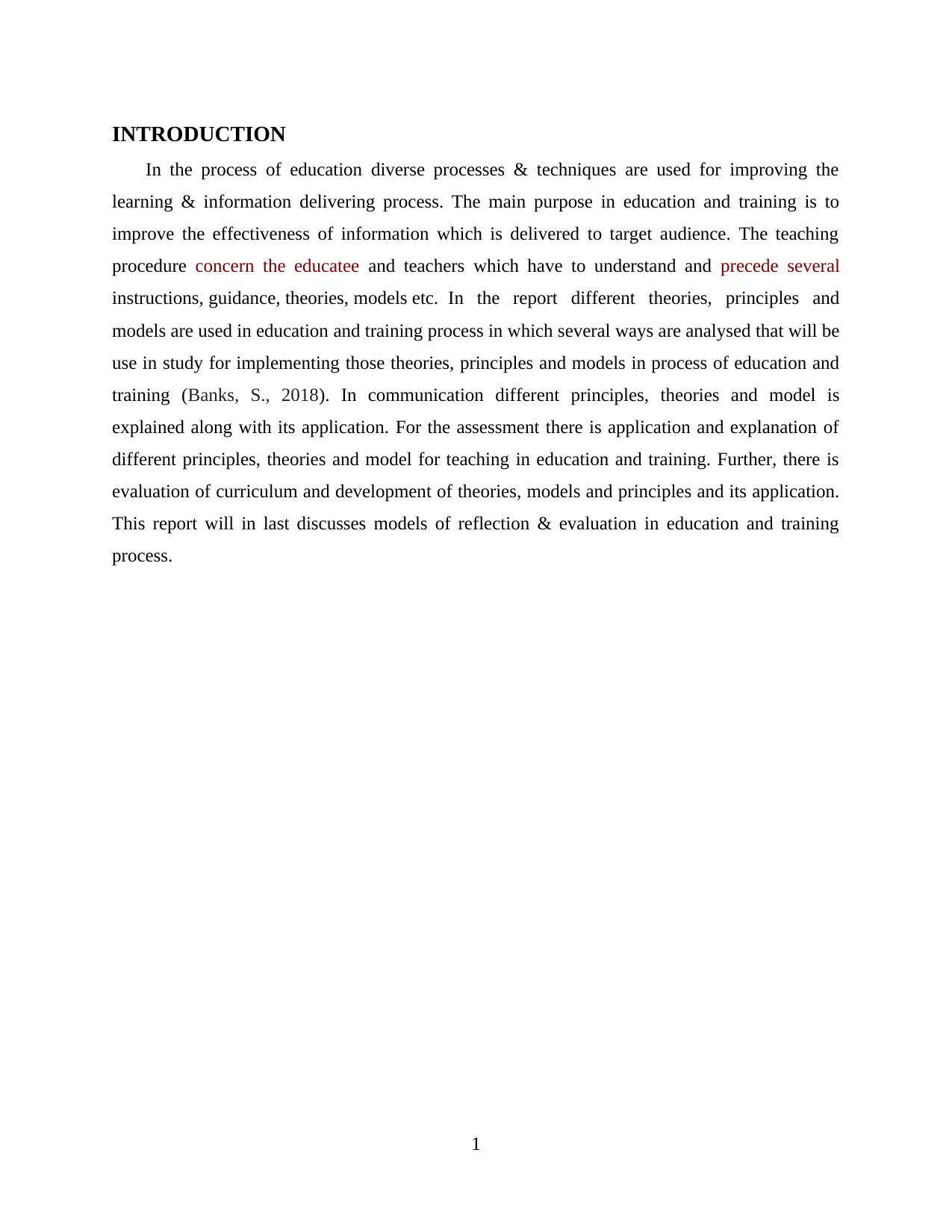
INTRODUCTION
In the process of education diverse processes & techniques are used for improving the
learning & information delivering process. The main purpose in education and training is to
improve the effectiveness of information which is delivered to target audience. The teaching
procedure concern the educatee and teachers which have to understand and precede several
instructions, guidance, theories, models etc. In the report different theories, principles and
models are used in education and training process in which several ways are analysed that will be
use in study for implementing those theories, principles and models in process of education and
training (Banks, S., 2018). In communication different principles, theories and model is
explained along with its application. For the assessment there is application and explanation of
different principles, theories and model for teaching in education and training. Further, there is
evaluation of curriculum and development of theories, models and principles and its application.
This report will in last discusses models of reflection & evaluation in education and training
process.
1
In the process of education diverse processes & techniques are used for improving the
learning & information delivering process. The main purpose in education and training is to
improve the effectiveness of information which is delivered to target audience. The teaching
procedure concern the educatee and teachers which have to understand and precede several
instructions, guidance, theories, models etc. In the report different theories, principles and
models are used in education and training process in which several ways are analysed that will be
use in study for implementing those theories, principles and models in process of education and
training (Banks, S., 2018). In communication different principles, theories and model is
explained along with its application. For the assessment there is application and explanation of
different principles, theories and model for teaching in education and training. Further, there is
evaluation of curriculum and development of theories, models and principles and its application.
This report will in last discusses models of reflection & evaluation in education and training
process.
1
⊘ This is a preview!⊘
Do you want full access?
Subscribe today to unlock all pages.

Trusted by 1+ million students worldwide
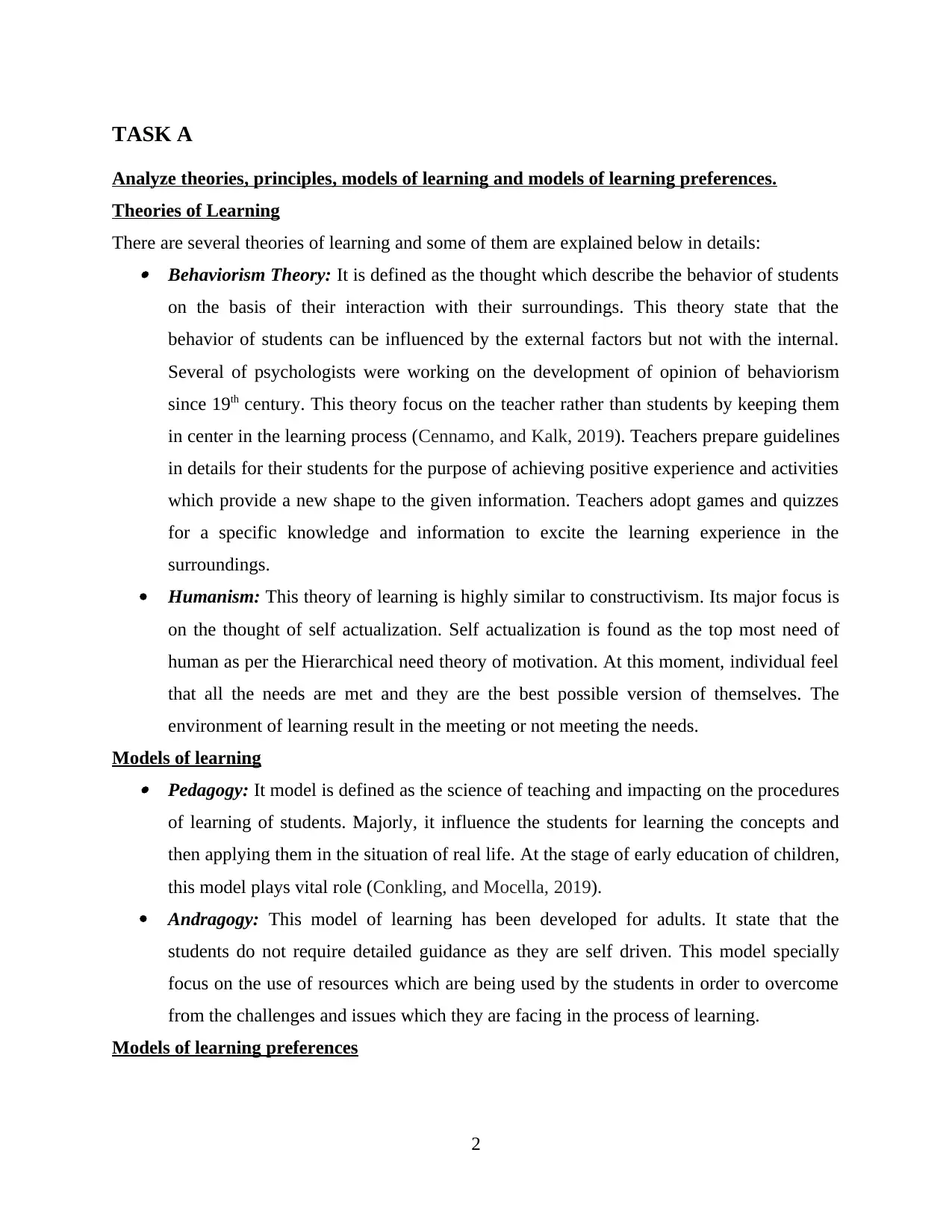
TASK A
Analyze theories, principles, models of learning and models of learning preferences.
Theories of Learning
There are several theories of learning and some of them are explained below in details: Behaviorism Theory: It is defined as the thought which describe the behavior of students
on the basis of their interaction with their surroundings. This theory state that the
behavior of students can be influenced by the external factors but not with the internal.
Several of psychologists were working on the development of opinion of behaviorism
since 19th century. This theory focus on the teacher rather than students by keeping them
in center in the learning process (Cennamo, and Kalk, 2019). Teachers prepare guidelines
in details for their students for the purpose of achieving positive experience and activities
which provide a new shape to the given information. Teachers adopt games and quizzes
for a specific knowledge and information to excite the learning experience in the
surroundings.
Humanism: This theory of learning is highly similar to constructivism. Its major focus is
on the thought of self actualization. Self actualization is found as the top most need of
human as per the Hierarchical need theory of motivation. At this moment, individual feel
that all the needs are met and they are the best possible version of themselves. The
environment of learning result in the meeting or not meeting the needs.
Models of learning Pedagogy: It model is defined as the science of teaching and impacting on the procedures
of learning of students. Majorly, it influence the students for learning the concepts and
then applying them in the situation of real life. At the stage of early education of children,
this model plays vital role (Conkling, and Mocella, 2019).
Andragogy: This model of learning has been developed for adults. It state that the
students do not require detailed guidance as they are self driven. This model specially
focus on the use of resources which are being used by the students in order to overcome
from the challenges and issues which they are facing in the process of learning.
Models of learning preferences
2
Analyze theories, principles, models of learning and models of learning preferences.
Theories of Learning
There are several theories of learning and some of them are explained below in details: Behaviorism Theory: It is defined as the thought which describe the behavior of students
on the basis of their interaction with their surroundings. This theory state that the
behavior of students can be influenced by the external factors but not with the internal.
Several of psychologists were working on the development of opinion of behaviorism
since 19th century. This theory focus on the teacher rather than students by keeping them
in center in the learning process (Cennamo, and Kalk, 2019). Teachers prepare guidelines
in details for their students for the purpose of achieving positive experience and activities
which provide a new shape to the given information. Teachers adopt games and quizzes
for a specific knowledge and information to excite the learning experience in the
surroundings.
Humanism: This theory of learning is highly similar to constructivism. Its major focus is
on the thought of self actualization. Self actualization is found as the top most need of
human as per the Hierarchical need theory of motivation. At this moment, individual feel
that all the needs are met and they are the best possible version of themselves. The
environment of learning result in the meeting or not meeting the needs.
Models of learning Pedagogy: It model is defined as the science of teaching and impacting on the procedures
of learning of students. Majorly, it influence the students for learning the concepts and
then applying them in the situation of real life. At the stage of early education of children,
this model plays vital role (Conkling, and Mocella, 2019).
Andragogy: This model of learning has been developed for adults. It state that the
students do not require detailed guidance as they are self driven. This model specially
focus on the use of resources which are being used by the students in order to overcome
from the challenges and issues which they are facing in the process of learning.
Models of learning preferences
2
Paraphrase This Document
Need a fresh take? Get an instant paraphrase of this document with our AI Paraphraser
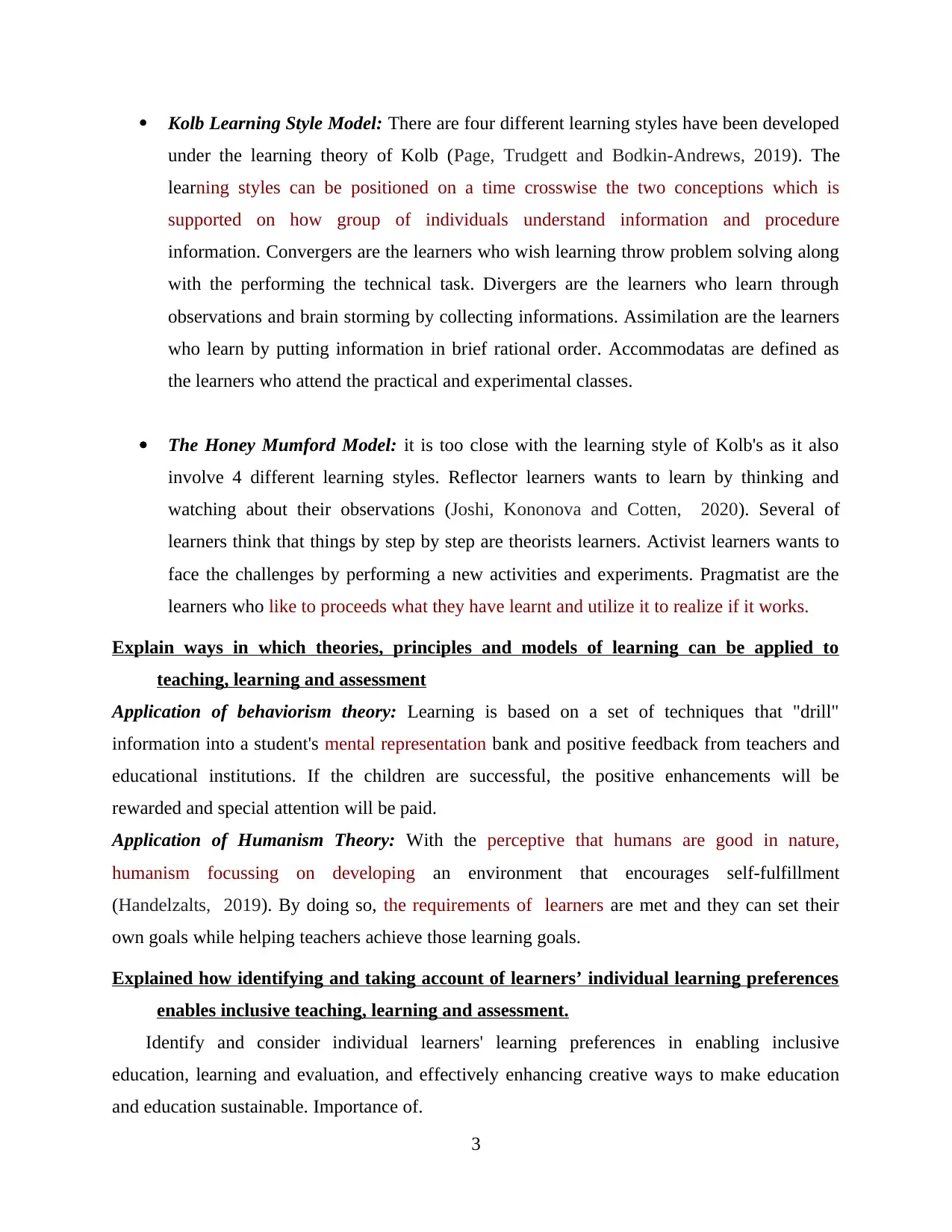
Kolb Learning Style Model: There are four different learning styles have been developed
under the learning theory of Kolb (Page, Trudgett and Bodkin-Andrews, 2019). The
learning styles can be positioned on a time crosswise the two conceptions which is
supported on how group of individuals understand information and procedure
information. Convergers are the learners who wish learning throw problem solving along
with the performing the technical task. Divergers are the learners who learn through
observations and brain storming by collecting informations. Assimilation are the learners
who learn by putting information in brief rational order. Accommodatas are defined as
the learners who attend the practical and experimental classes.
The Honey Mumford Model: it is too close with the learning style of Kolb's as it also
involve 4 different learning styles. Reflector learners wants to learn by thinking and
watching about their observations (Joshi, Kononova and Cotten, 2020). Several of
learners think that things by step by step are theorists learners. Activist learners wants to
face the challenges by performing a new activities and experiments. Pragmatist are the
learners who like to proceeds what they have learnt and utilize it to realize if it works.
Explain ways in which theories, principles and models of learning can be applied to
teaching, learning and assessment
Application of behaviorism theory: Learning is based on a set of techniques that "drill"
information into a student's mental representation bank and positive feedback from teachers and
educational institutions. If the children are successful, the positive enhancements will be
rewarded and special attention will be paid.
Application of Humanism Theory: With the perceptive that humans are good in nature,
humanism focussing on developing an environment that encourages self-fulfillment
(Handelzalts, 2019). By doing so, the requirements of learners are met and they can set their
own goals while helping teachers achieve those learning goals.
Explained how identifying and taking account of learners’ individual learning preferences
enables inclusive teaching, learning and assessment.
Identify and consider individual learners' learning preferences in enabling inclusive
education, learning and evaluation, and effectively enhancing creative ways to make education
and education sustainable. Importance of.
3
under the learning theory of Kolb (Page, Trudgett and Bodkin-Andrews, 2019). The
learning styles can be positioned on a time crosswise the two conceptions which is
supported on how group of individuals understand information and procedure
information. Convergers are the learners who wish learning throw problem solving along
with the performing the technical task. Divergers are the learners who learn through
observations and brain storming by collecting informations. Assimilation are the learners
who learn by putting information in brief rational order. Accommodatas are defined as
the learners who attend the practical and experimental classes.
The Honey Mumford Model: it is too close with the learning style of Kolb's as it also
involve 4 different learning styles. Reflector learners wants to learn by thinking and
watching about their observations (Joshi, Kononova and Cotten, 2020). Several of
learners think that things by step by step are theorists learners. Activist learners wants to
face the challenges by performing a new activities and experiments. Pragmatist are the
learners who like to proceeds what they have learnt and utilize it to realize if it works.
Explain ways in which theories, principles and models of learning can be applied to
teaching, learning and assessment
Application of behaviorism theory: Learning is based on a set of techniques that "drill"
information into a student's mental representation bank and positive feedback from teachers and
educational institutions. If the children are successful, the positive enhancements will be
rewarded and special attention will be paid.
Application of Humanism Theory: With the perceptive that humans are good in nature,
humanism focussing on developing an environment that encourages self-fulfillment
(Handelzalts, 2019). By doing so, the requirements of learners are met and they can set their
own goals while helping teachers achieve those learning goals.
Explained how identifying and taking account of learners’ individual learning preferences
enables inclusive teaching, learning and assessment.
Identify and consider individual learners' learning preferences in enabling inclusive
education, learning and evaluation, and effectively enhancing creative ways to make education
and education sustainable. Importance of.
3
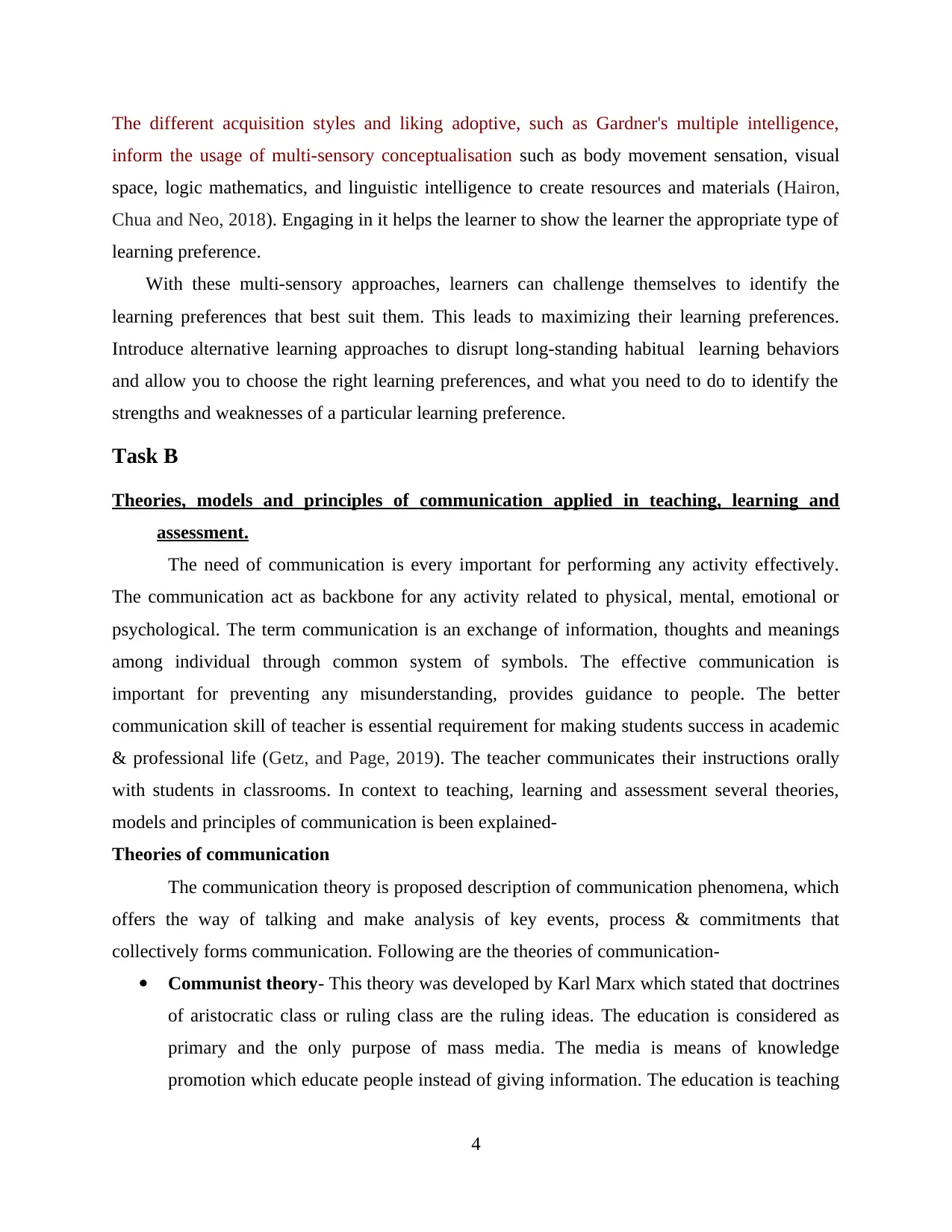
The different acquisition styles and liking adoptive, such as Gardner's multiple intelligence,
inform the usage of multi-sensory conceptualisation such as body movement sensation, visual
space, logic mathematics, and linguistic intelligence to create resources and materials (Hairon,
Chua and Neo, 2018). Engaging in it helps the learner to show the learner the appropriate type of
learning preference.
With these multi-sensory approaches, learners can challenge themselves to identify the
learning preferences that best suit them. This leads to maximizing their learning preferences.
Introduce alternative learning approaches to disrupt long-standing habitual learning behaviors
and allow you to choose the right learning preferences, and what you need to do to identify the
strengths and weaknesses of a particular learning preference.
Task B
Theories, models and principles of communication applied in teaching, learning and
assessment.
The need of communication is every important for performing any activity effectively.
The communication act as backbone for any activity related to physical, mental, emotional or
psychological. The term communication is an exchange of information, thoughts and meanings
among individual through common system of symbols. The effective communication is
important for preventing any misunderstanding, provides guidance to people. The better
communication skill of teacher is essential requirement for making students success in academic
& professional life (Getz, and Page, 2019). The teacher communicates their instructions orally
with students in classrooms. In context to teaching, learning and assessment several theories,
models and principles of communication is been explained-
Theories of communication
The communication theory is proposed description of communication phenomena, which
offers the way of talking and make analysis of key events, process & commitments that
collectively forms communication. Following are the theories of communication-
Communist theory- This theory was developed by Karl Marx which stated that doctrines
of aristocratic class or ruling class are the ruling ideas. The education is considered as
primary and the only purpose of mass media. The media is means of knowledge
promotion which educate people instead of giving information. The education is teaching
4
inform the usage of multi-sensory conceptualisation such as body movement sensation, visual
space, logic mathematics, and linguistic intelligence to create resources and materials (Hairon,
Chua and Neo, 2018). Engaging in it helps the learner to show the learner the appropriate type of
learning preference.
With these multi-sensory approaches, learners can challenge themselves to identify the
learning preferences that best suit them. This leads to maximizing their learning preferences.
Introduce alternative learning approaches to disrupt long-standing habitual learning behaviors
and allow you to choose the right learning preferences, and what you need to do to identify the
strengths and weaknesses of a particular learning preference.
Task B
Theories, models and principles of communication applied in teaching, learning and
assessment.
The need of communication is every important for performing any activity effectively.
The communication act as backbone for any activity related to physical, mental, emotional or
psychological. The term communication is an exchange of information, thoughts and meanings
among individual through common system of symbols. The effective communication is
important for preventing any misunderstanding, provides guidance to people. The better
communication skill of teacher is essential requirement for making students success in academic
& professional life (Getz, and Page, 2019). The teacher communicates their instructions orally
with students in classrooms. In context to teaching, learning and assessment several theories,
models and principles of communication is been explained-
Theories of communication
The communication theory is proposed description of communication phenomena, which
offers the way of talking and make analysis of key events, process & commitments that
collectively forms communication. Following are the theories of communication-
Communist theory- This theory was developed by Karl Marx which stated that doctrines
of aristocratic class or ruling class are the ruling ideas. The education is considered as
primary and the only purpose of mass media. The media is means of knowledge
promotion which educate people instead of giving information. The education is teaching
4
⊘ This is a preview!⊘
Do you want full access?
Subscribe today to unlock all pages.

Trusted by 1+ million students worldwide
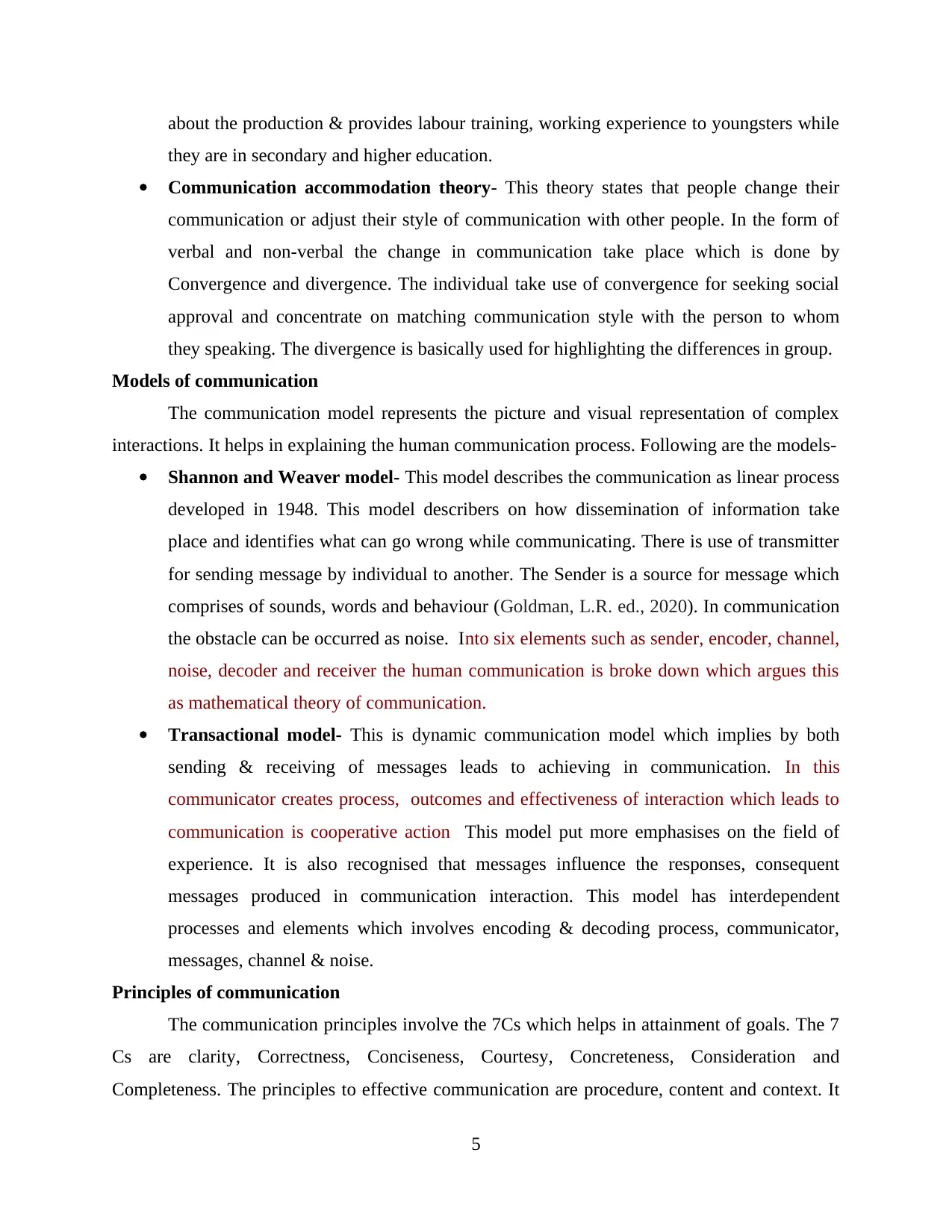
about the production & provides labour training, working experience to youngsters while
they are in secondary and higher education.
Communication accommodation theory- This theory states that people change their
communication or adjust their style of communication with other people. In the form of
verbal and non-verbal the change in communication take place which is done by
Convergence and divergence. The individual take use of convergence for seeking social
approval and concentrate on matching communication style with the person to whom
they speaking. The divergence is basically used for highlighting the differences in group.
Models of communication
The communication model represents the picture and visual representation of complex
interactions. It helps in explaining the human communication process. Following are the models-
Shannon and Weaver model- This model describes the communication as linear process
developed in 1948. This model describers on how dissemination of information take
place and identifies what can go wrong while communicating. There is use of transmitter
for sending message by individual to another. The Sender is a source for message which
comprises of sounds, words and behaviour (Goldman, L.R. ed., 2020). In communication
the obstacle can be occurred as noise. Into six elements such as sender, encoder, channel,
noise, decoder and receiver the human communication is broke down which argues this
as mathematical theory of communication.
Transactional model- This is dynamic communication model which implies by both
sending & receiving of messages leads to achieving in communication. In this
communicator creates process, outcomes and effectiveness of interaction which leads to
communication is cooperative action This model put more emphasises on the field of
experience. It is also recognised that messages influence the responses, consequent
messages produced in communication interaction. This model has interdependent
processes and elements which involves encoding & decoding process, communicator,
messages, channel & noise.
Principles of communication
The communication principles involve the 7Cs which helps in attainment of goals. The 7
Cs are clarity, Correctness, Conciseness, Courtesy, Concreteness, Consideration and
Completeness. The principles to effective communication are procedure, content and context. It
5
they are in secondary and higher education.
Communication accommodation theory- This theory states that people change their
communication or adjust their style of communication with other people. In the form of
verbal and non-verbal the change in communication take place which is done by
Convergence and divergence. The individual take use of convergence for seeking social
approval and concentrate on matching communication style with the person to whom
they speaking. The divergence is basically used for highlighting the differences in group.
Models of communication
The communication model represents the picture and visual representation of complex
interactions. It helps in explaining the human communication process. Following are the models-
Shannon and Weaver model- This model describes the communication as linear process
developed in 1948. This model describers on how dissemination of information take
place and identifies what can go wrong while communicating. There is use of transmitter
for sending message by individual to another. The Sender is a source for message which
comprises of sounds, words and behaviour (Goldman, L.R. ed., 2020). In communication
the obstacle can be occurred as noise. Into six elements such as sender, encoder, channel,
noise, decoder and receiver the human communication is broke down which argues this
as mathematical theory of communication.
Transactional model- This is dynamic communication model which implies by both
sending & receiving of messages leads to achieving in communication. In this
communicator creates process, outcomes and effectiveness of interaction which leads to
communication is cooperative action This model put more emphasises on the field of
experience. It is also recognised that messages influence the responses, consequent
messages produced in communication interaction. This model has interdependent
processes and elements which involves encoding & decoding process, communicator,
messages, channel & noise.
Principles of communication
The communication principles involve the 7Cs which helps in attainment of goals. The 7
Cs are clarity, Correctness, Conciseness, Courtesy, Concreteness, Consideration and
Completeness. The principles to effective communication are procedure, content and context. It
5
Paraphrase This Document
Need a fresh take? Get an instant paraphrase of this document with our AI Paraphraser
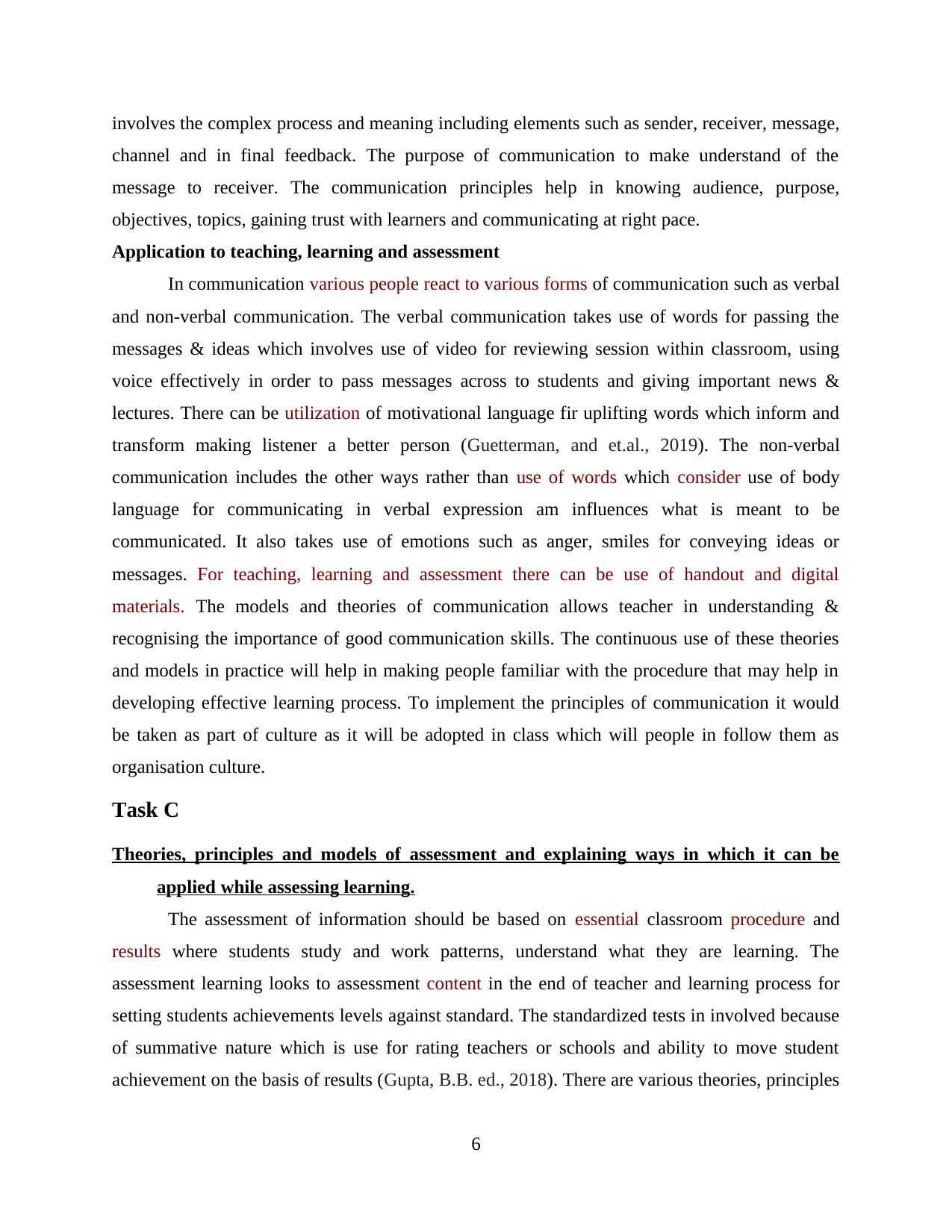
involves the complex process and meaning including elements such as sender, receiver, message,
channel and in final feedback. The purpose of communication to make understand of the
message to receiver. The communication principles help in knowing audience, purpose,
objectives, topics, gaining trust with learners and communicating at right pace.
Application to teaching, learning and assessment
In communication various people react to various forms of communication such as verbal
and non-verbal communication. The verbal communication takes use of words for passing the
messages & ideas which involves use of video for reviewing session within classroom, using
voice effectively in order to pass messages across to students and giving important news &
lectures. There can be utilization of motivational language fir uplifting words which inform and
transform making listener a better person (Guetterman, and et.al., 2019). The non-verbal
communication includes the other ways rather than use of words which consider use of body
language for communicating in verbal expression am influences what is meant to be
communicated. It also takes use of emotions such as anger, smiles for conveying ideas or
messages. For teaching, learning and assessment there can be use of handout and digital
materials. The models and theories of communication allows teacher in understanding &
recognising the importance of good communication skills. The continuous use of these theories
and models in practice will help in making people familiar with the procedure that may help in
developing effective learning process. To implement the principles of communication it would
be taken as part of culture as it will be adopted in class which will people in follow them as
organisation culture.
Task C
Theories, principles and models of assessment and explaining ways in which it can be
applied while assessing learning.
The assessment of information should be based on essential classroom procedure and
results where students study and work patterns, understand what they are learning. The
assessment learning looks to assessment content in the end of teacher and learning process for
setting students achievements levels against standard. The standardized tests in involved because
of summative nature which is use for rating teachers or schools and ability to move student
achievement on the basis of results (Gupta, B.B. ed., 2018). There are various theories, principles
6
channel and in final feedback. The purpose of communication to make understand of the
message to receiver. The communication principles help in knowing audience, purpose,
objectives, topics, gaining trust with learners and communicating at right pace.
Application to teaching, learning and assessment
In communication various people react to various forms of communication such as verbal
and non-verbal communication. The verbal communication takes use of words for passing the
messages & ideas which involves use of video for reviewing session within classroom, using
voice effectively in order to pass messages across to students and giving important news &
lectures. There can be utilization of motivational language fir uplifting words which inform and
transform making listener a better person (Guetterman, and et.al., 2019). The non-verbal
communication includes the other ways rather than use of words which consider use of body
language for communicating in verbal expression am influences what is meant to be
communicated. It also takes use of emotions such as anger, smiles for conveying ideas or
messages. For teaching, learning and assessment there can be use of handout and digital
materials. The models and theories of communication allows teacher in understanding &
recognising the importance of good communication skills. The continuous use of these theories
and models in practice will help in making people familiar with the procedure that may help in
developing effective learning process. To implement the principles of communication it would
be taken as part of culture as it will be adopted in class which will people in follow them as
organisation culture.
Task C
Theories, principles and models of assessment and explaining ways in which it can be
applied while assessing learning.
The assessment of information should be based on essential classroom procedure and
results where students study and work patterns, understand what they are learning. The
assessment learning looks to assessment content in the end of teacher and learning process for
setting students achievements levels against standard. The standardized tests in involved because
of summative nature which is use for rating teachers or schools and ability to move student
achievement on the basis of results (Gupta, B.B. ed., 2018). There are various theories, principles
6
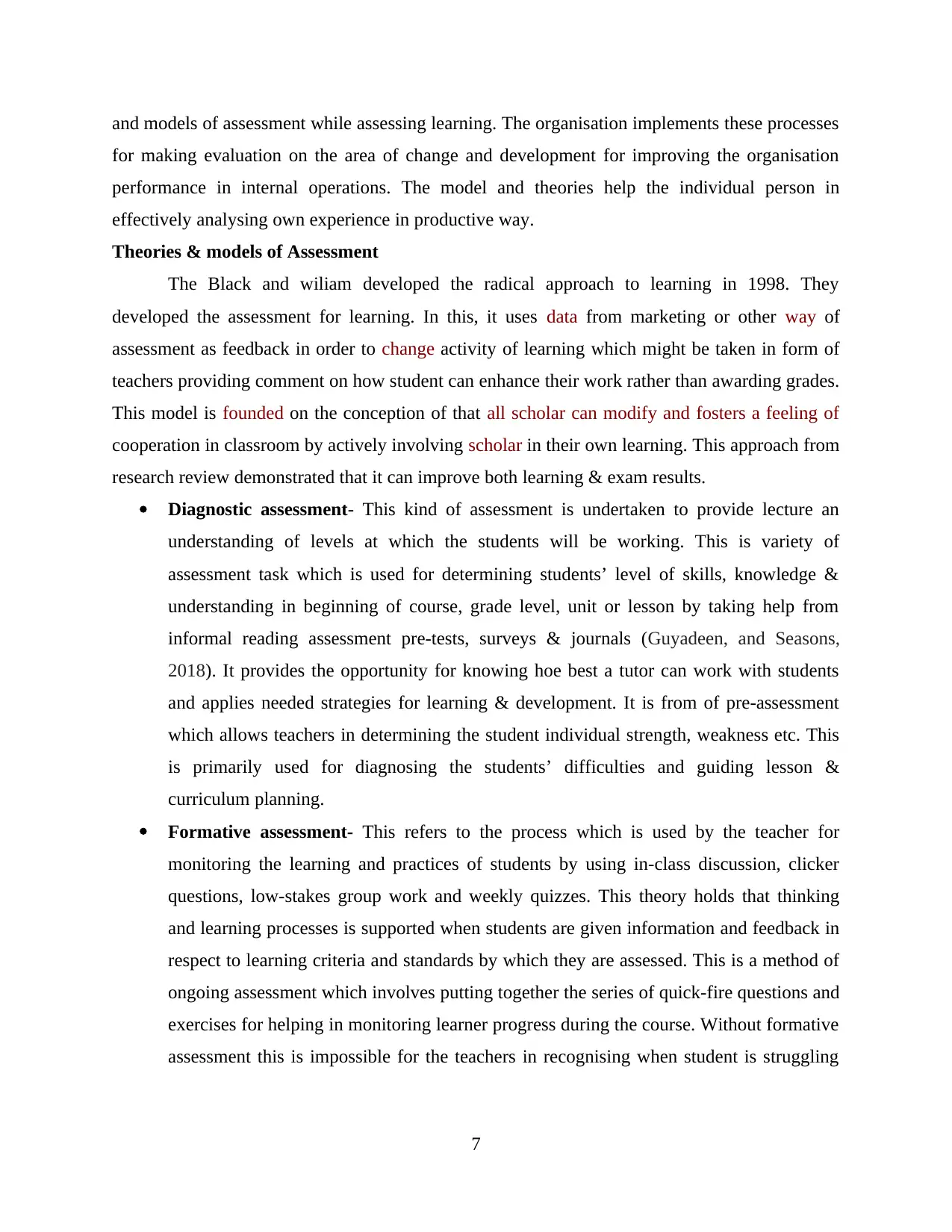
and models of assessment while assessing learning. The organisation implements these processes
for making evaluation on the area of change and development for improving the organisation
performance in internal operations. The model and theories help the individual person in
effectively analysing own experience in productive way.
Theories & models of Assessment
The Black and wiliam developed the radical approach to learning in 1998. They
developed the assessment for learning. In this, it uses data from marketing or other way of
assessment as feedback in order to change activity of learning which might be taken in form of
teachers providing comment on how student can enhance their work rather than awarding grades.
This model is founded on the conception of that all scholar can modify and fosters a feeling of
cooperation in classroom by actively involving scholar in their own learning. This approach from
research review demonstrated that it can improve both learning & exam results.
Diagnostic assessment- This kind of assessment is undertaken to provide lecture an
understanding of levels at which the students will be working. This is variety of
assessment task which is used for determining students’ level of skills, knowledge &
understanding in beginning of course, grade level, unit or lesson by taking help from
informal reading assessment pre-tests, surveys & journals (Guyadeen, and Seasons,
2018). It provides the opportunity for knowing hoe best a tutor can work with students
and applies needed strategies for learning & development. It is from of pre-assessment
which allows teachers in determining the student individual strength, weakness etc. This
is primarily used for diagnosing the students’ difficulties and guiding lesson &
curriculum planning.
Formative assessment- This refers to the process which is used by the teacher for
monitoring the learning and practices of students by using in-class discussion, clicker
questions, low-stakes group work and weekly quizzes. This theory holds that thinking
and learning processes is supported when students are given information and feedback in
respect to learning criteria and standards by which they are assessed. This is a method of
ongoing assessment which involves putting together the series of quick-fire questions and
exercises for helping in monitoring learner progress during the course. Without formative
assessment this is impossible for the teachers in recognising when student is struggling
7
for making evaluation on the area of change and development for improving the organisation
performance in internal operations. The model and theories help the individual person in
effectively analysing own experience in productive way.
Theories & models of Assessment
The Black and wiliam developed the radical approach to learning in 1998. They
developed the assessment for learning. In this, it uses data from marketing or other way of
assessment as feedback in order to change activity of learning which might be taken in form of
teachers providing comment on how student can enhance their work rather than awarding grades.
This model is founded on the conception of that all scholar can modify and fosters a feeling of
cooperation in classroom by actively involving scholar in their own learning. This approach from
research review demonstrated that it can improve both learning & exam results.
Diagnostic assessment- This kind of assessment is undertaken to provide lecture an
understanding of levels at which the students will be working. This is variety of
assessment task which is used for determining students’ level of skills, knowledge &
understanding in beginning of course, grade level, unit or lesson by taking help from
informal reading assessment pre-tests, surveys & journals (Guyadeen, and Seasons,
2018). It provides the opportunity for knowing hoe best a tutor can work with students
and applies needed strategies for learning & development. It is from of pre-assessment
which allows teachers in determining the student individual strength, weakness etc. This
is primarily used for diagnosing the students’ difficulties and guiding lesson &
curriculum planning.
Formative assessment- This refers to the process which is used by the teacher for
monitoring the learning and practices of students by using in-class discussion, clicker
questions, low-stakes group work and weekly quizzes. This theory holds that thinking
and learning processes is supported when students are given information and feedback in
respect to learning criteria and standards by which they are assessed. This is a method of
ongoing assessment which involves putting together the series of quick-fire questions and
exercises for helping in monitoring learner progress during the course. Without formative
assessment this is impossible for the teachers in recognising when student is struggling
7
⊘ This is a preview!⊘
Do you want full access?
Subscribe today to unlock all pages.

Trusted by 1+ million students worldwide
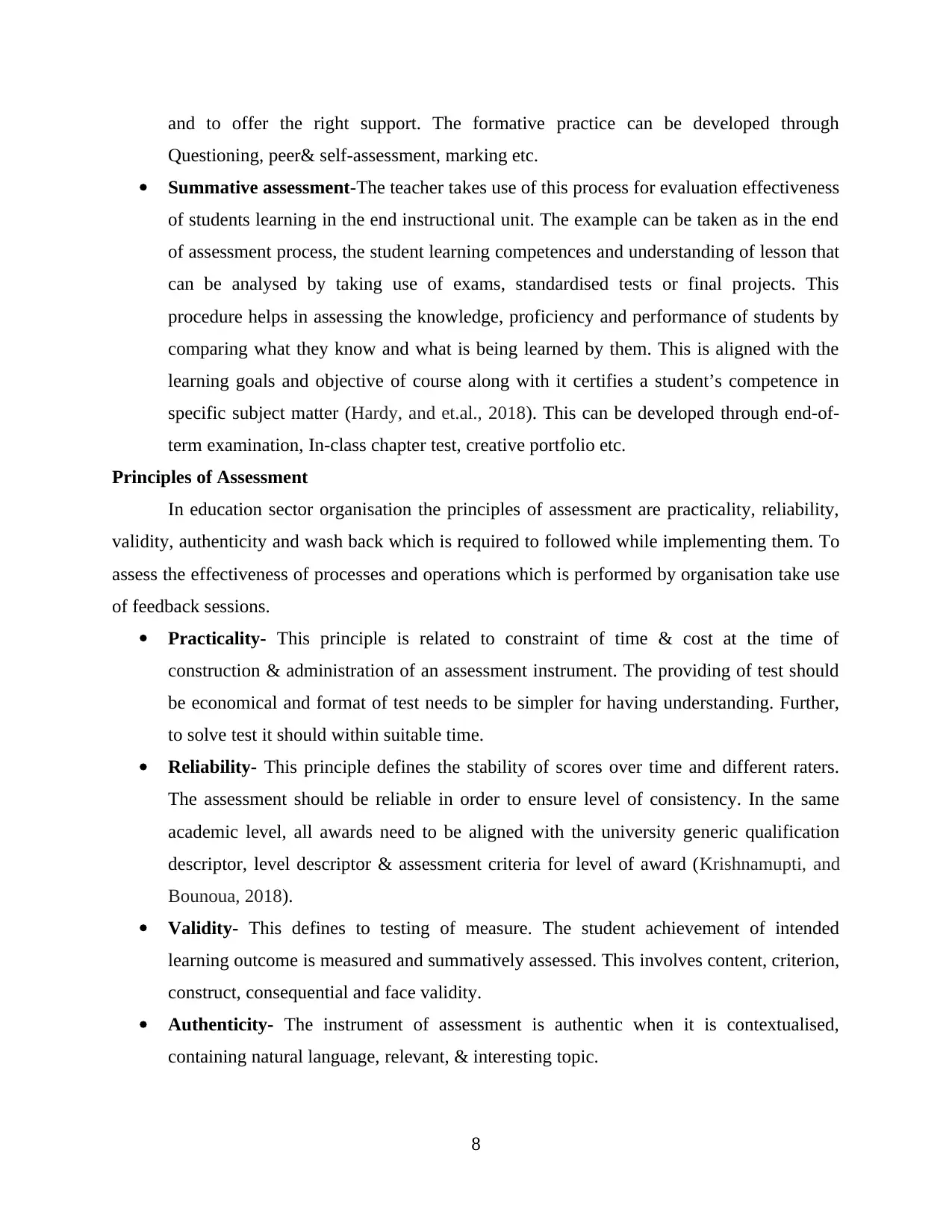
and to offer the right support. The formative practice can be developed through
Questioning, peer& self-assessment, marking etc.
Summative assessment-The teacher takes use of this process for evaluation effectiveness
of students learning in the end instructional unit. The example can be taken as in the end
of assessment process, the student learning competences and understanding of lesson that
can be analysed by taking use of exams, standardised tests or final projects. This
procedure helps in assessing the knowledge, proficiency and performance of students by
comparing what they know and what is being learned by them. This is aligned with the
learning goals and objective of course along with it certifies a student’s competence in
specific subject matter (Hardy, and et.al., 2018). This can be developed through end-of-
term examination, In-class chapter test, creative portfolio etc.
Principles of Assessment
In education sector organisation the principles of assessment are practicality, reliability,
validity, authenticity and wash back which is required to followed while implementing them. To
assess the effectiveness of processes and operations which is performed by organisation take use
of feedback sessions.
Practicality- This principle is related to constraint of time & cost at the time of
construction & administration of an assessment instrument. The providing of test should
be economical and format of test needs to be simpler for having understanding. Further,
to solve test it should within suitable time.
Reliability- This principle defines the stability of scores over time and different raters.
The assessment should be reliable in order to ensure level of consistency. In the same
academic level, all awards need to be aligned with the university generic qualification
descriptor, level descriptor & assessment criteria for level of award (Krishnamupti, and
Bounoua, 2018).
Validity- This defines to testing of measure. The student achievement of intended
learning outcome is measured and summatively assessed. This involves content, criterion,
construct, consequential and face validity.
Authenticity- The instrument of assessment is authentic when it is contextualised,
containing natural language, relevant, & interesting topic.
8
Questioning, peer& self-assessment, marking etc.
Summative assessment-The teacher takes use of this process for evaluation effectiveness
of students learning in the end instructional unit. The example can be taken as in the end
of assessment process, the student learning competences and understanding of lesson that
can be analysed by taking use of exams, standardised tests or final projects. This
procedure helps in assessing the knowledge, proficiency and performance of students by
comparing what they know and what is being learned by them. This is aligned with the
learning goals and objective of course along with it certifies a student’s competence in
specific subject matter (Hardy, and et.al., 2018). This can be developed through end-of-
term examination, In-class chapter test, creative portfolio etc.
Principles of Assessment
In education sector organisation the principles of assessment are practicality, reliability,
validity, authenticity and wash back which is required to followed while implementing them. To
assess the effectiveness of processes and operations which is performed by organisation take use
of feedback sessions.
Practicality- This principle is related to constraint of time & cost at the time of
construction & administration of an assessment instrument. The providing of test should
be economical and format of test needs to be simpler for having understanding. Further,
to solve test it should within suitable time.
Reliability- This principle defines the stability of scores over time and different raters.
The assessment should be reliable in order to ensure level of consistency. In the same
academic level, all awards need to be aligned with the university generic qualification
descriptor, level descriptor & assessment criteria for level of award (Krishnamupti, and
Bounoua, 2018).
Validity- This defines to testing of measure. The student achievement of intended
learning outcome is measured and summatively assessed. This involves content, criterion,
construct, consequential and face validity.
Authenticity- The instrument of assessment is authentic when it is contextualised,
containing natural language, relevant, & interesting topic.
8
Paraphrase This Document
Need a fresh take? Get an instant paraphrase of this document with our AI Paraphraser
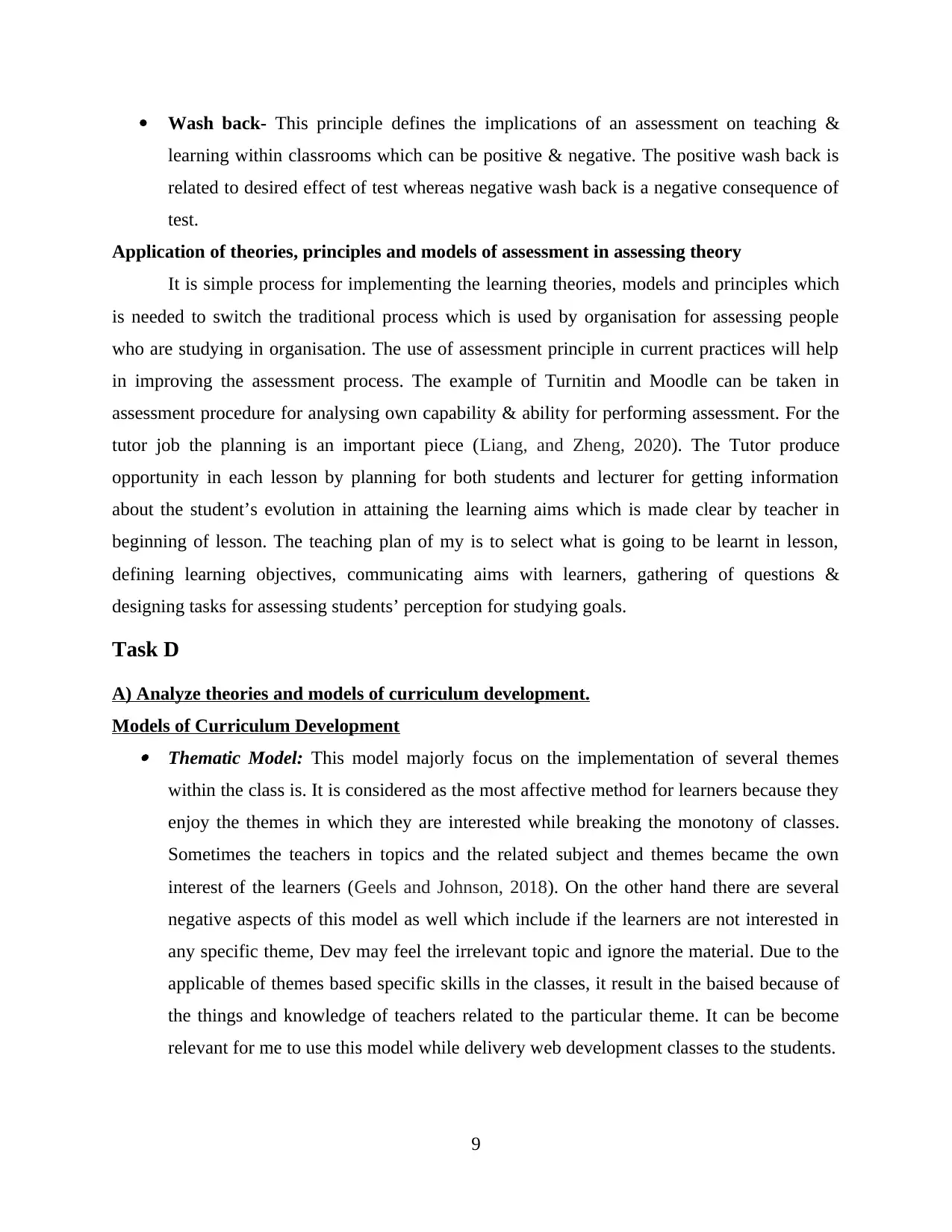
Wash back- This principle defines the implications of an assessment on teaching &
learning within classrooms which can be positive & negative. The positive wash back is
related to desired effect of test whereas negative wash back is a negative consequence of
test.
Application of theories, principles and models of assessment in assessing theory
It is simple process for implementing the learning theories, models and principles which
is needed to switch the traditional process which is used by organisation for assessing people
who are studying in organisation. The use of assessment principle in current practices will help
in improving the assessment process. The example of Turnitin and Moodle can be taken in
assessment procedure for analysing own capability & ability for performing assessment. For the
tutor job the planning is an important piece (Liang, and Zheng, 2020). The Tutor produce
opportunity in each lesson by planning for both students and lecturer for getting information
about the student’s evolution in attaining the learning aims which is made clear by teacher in
beginning of lesson. The teaching plan of my is to select what is going to be learnt in lesson,
defining learning objectives, communicating aims with learners, gathering of questions &
designing tasks for assessing students’ perception for studying goals.
Task D
A) Analyze theories and models of curriculum development.
Models of Curriculum Development Thematic Model: This model majorly focus on the implementation of several themes
within the class is. It is considered as the most affective method for learners because they
enjoy the themes in which they are interested while breaking the monotony of classes.
Sometimes the teachers in topics and the related subject and themes became the own
interest of the learners (Geels and Johnson, 2018). On the other hand there are several
negative aspects of this model as well which include if the learners are not interested in
any specific theme, Dev may feel the irrelevant topic and ignore the material. Due to the
applicable of themes based specific skills in the classes, it result in the baised because of
the things and knowledge of teachers related to the particular theme. It can be become
relevant for me to use this model while delivery web development classes to the students.
9
learning within classrooms which can be positive & negative. The positive wash back is
related to desired effect of test whereas negative wash back is a negative consequence of
test.
Application of theories, principles and models of assessment in assessing theory
It is simple process for implementing the learning theories, models and principles which
is needed to switch the traditional process which is used by organisation for assessing people
who are studying in organisation. The use of assessment principle in current practices will help
in improving the assessment process. The example of Turnitin and Moodle can be taken in
assessment procedure for analysing own capability & ability for performing assessment. For the
tutor job the planning is an important piece (Liang, and Zheng, 2020). The Tutor produce
opportunity in each lesson by planning for both students and lecturer for getting information
about the student’s evolution in attaining the learning aims which is made clear by teacher in
beginning of lesson. The teaching plan of my is to select what is going to be learnt in lesson,
defining learning objectives, communicating aims with learners, gathering of questions &
designing tasks for assessing students’ perception for studying goals.
Task D
A) Analyze theories and models of curriculum development.
Models of Curriculum Development Thematic Model: This model majorly focus on the implementation of several themes
within the class is. It is considered as the most affective method for learners because they
enjoy the themes in which they are interested while breaking the monotony of classes.
Sometimes the teachers in topics and the related subject and themes became the own
interest of the learners (Geels and Johnson, 2018). On the other hand there are several
negative aspects of this model as well which include if the learners are not interested in
any specific theme, Dev may feel the irrelevant topic and ignore the material. Due to the
applicable of themes based specific skills in the classes, it result in the baised because of
the things and knowledge of teachers related to the particular theme. It can be become
relevant for me to use this model while delivery web development classes to the students.
9
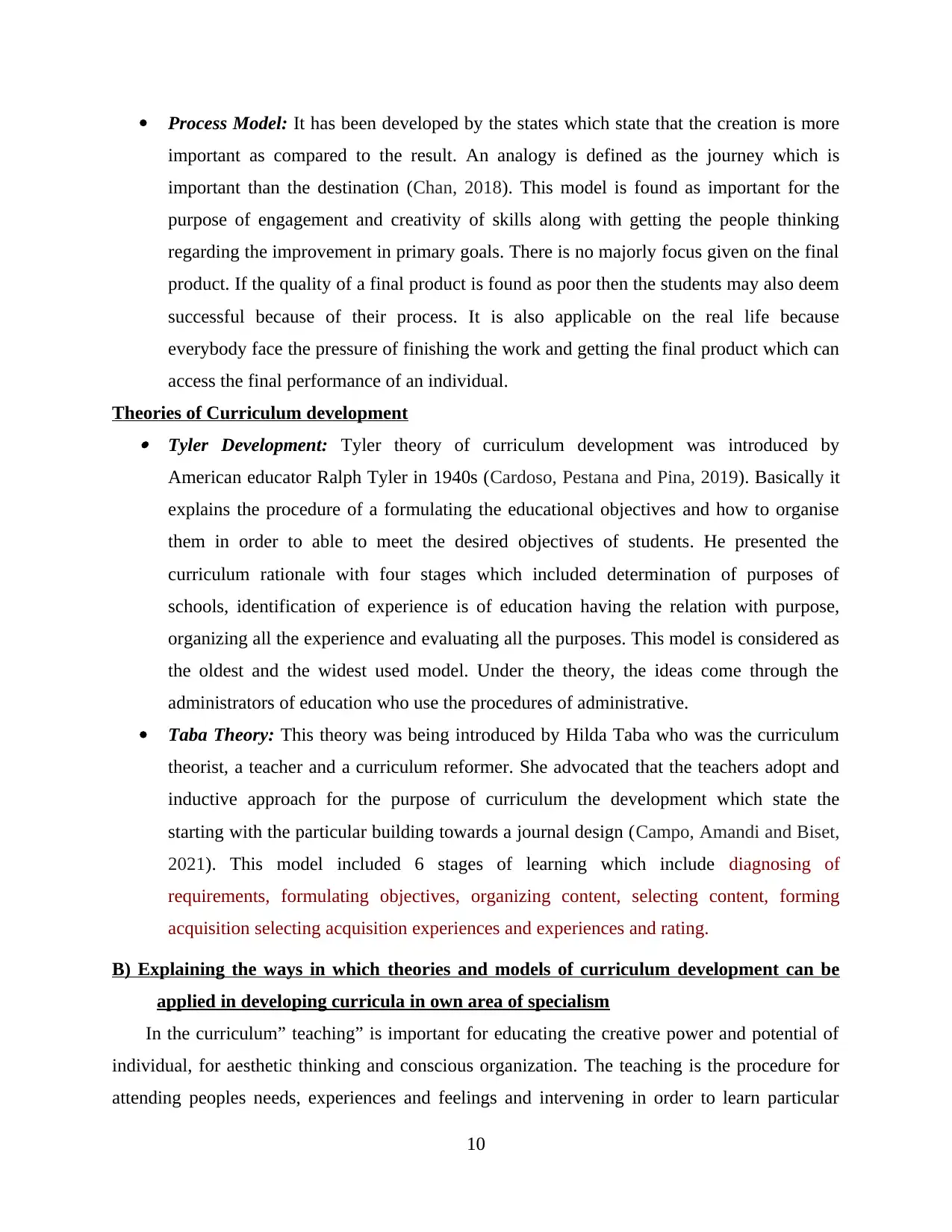
Process Model: It has been developed by the states which state that the creation is more
important as compared to the result. An analogy is defined as the journey which is
important than the destination (Chan, 2018). This model is found as important for the
purpose of engagement and creativity of skills along with getting the people thinking
regarding the improvement in primary goals. There is no majorly focus given on the final
product. If the quality of a final product is found as poor then the students may also deem
successful because of their process. It is also applicable on the real life because
everybody face the pressure of finishing the work and getting the final product which can
access the final performance of an individual.
Theories of Curriculum development Tyler Development: Tyler theory of curriculum development was introduced by
American educator Ralph Tyler in 1940s (Cardoso, Pestana and Pina, 2019). Basically it
explains the procedure of a formulating the educational objectives and how to organise
them in order to able to meet the desired objectives of students. He presented the
curriculum rationale with four stages which included determination of purposes of
schools, identification of experience is of education having the relation with purpose,
organizing all the experience and evaluating all the purposes. This model is considered as
the oldest and the widest used model. Under the theory, the ideas come through the
administrators of education who use the procedures of administrative.
Taba Theory: This theory was being introduced by Hilda Taba who was the curriculum
theorist, a teacher and a curriculum reformer. She advocated that the teachers adopt and
inductive approach for the purpose of curriculum the development which state the
starting with the particular building towards a journal design (Campo, Amandi and Biset,
2021). This model included 6 stages of learning which include diagnosing of
requirements, formulating objectives, organizing content, selecting content, forming
acquisition selecting acquisition experiences and experiences and rating.
B) Explaining the ways in which theories and models of curriculum development can be
applied in developing curricula in own area of specialism
In the curriculum” teaching” is important for educating the creative power and potential of
individual, for aesthetic thinking and conscious organization. The teaching is the procedure for
attending peoples needs, experiences and feelings and intervening in order to learn particular
10
important as compared to the result. An analogy is defined as the journey which is
important than the destination (Chan, 2018). This model is found as important for the
purpose of engagement and creativity of skills along with getting the people thinking
regarding the improvement in primary goals. There is no majorly focus given on the final
product. If the quality of a final product is found as poor then the students may also deem
successful because of their process. It is also applicable on the real life because
everybody face the pressure of finishing the work and getting the final product which can
access the final performance of an individual.
Theories of Curriculum development Tyler Development: Tyler theory of curriculum development was introduced by
American educator Ralph Tyler in 1940s (Cardoso, Pestana and Pina, 2019). Basically it
explains the procedure of a formulating the educational objectives and how to organise
them in order to able to meet the desired objectives of students. He presented the
curriculum rationale with four stages which included determination of purposes of
schools, identification of experience is of education having the relation with purpose,
organizing all the experience and evaluating all the purposes. This model is considered as
the oldest and the widest used model. Under the theory, the ideas come through the
administrators of education who use the procedures of administrative.
Taba Theory: This theory was being introduced by Hilda Taba who was the curriculum
theorist, a teacher and a curriculum reformer. She advocated that the teachers adopt and
inductive approach for the purpose of curriculum the development which state the
starting with the particular building towards a journal design (Campo, Amandi and Biset,
2021). This model included 6 stages of learning which include diagnosing of
requirements, formulating objectives, organizing content, selecting content, forming
acquisition selecting acquisition experiences and experiences and rating.
B) Explaining the ways in which theories and models of curriculum development can be
applied in developing curricula in own area of specialism
In the curriculum” teaching” is important for educating the creative power and potential of
individual, for aesthetic thinking and conscious organization. The teaching is the procedure for
attending peoples needs, experiences and feelings and intervening in order to learn particular
10
⊘ This is a preview!⊘
Do you want full access?
Subscribe today to unlock all pages.

Trusted by 1+ million students worldwide
1 out of 19
Related Documents
Your All-in-One AI-Powered Toolkit for Academic Success.
+13062052269
info@desklib.com
Available 24*7 on WhatsApp / Email
![[object Object]](/_next/static/media/star-bottom.7253800d.svg)
Unlock your academic potential
Copyright © 2020–2025 A2Z Services. All Rights Reserved. Developed and managed by ZUCOL.

